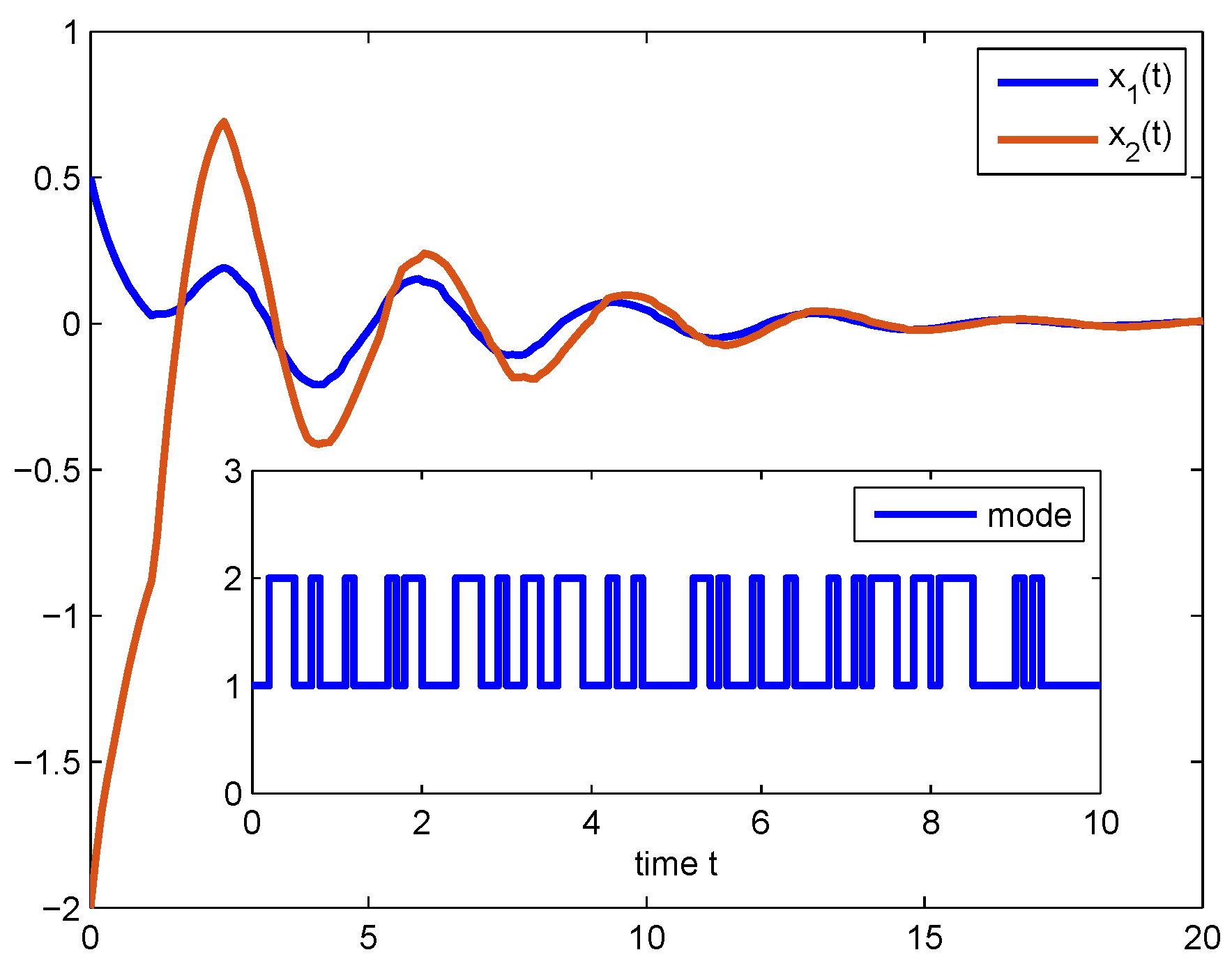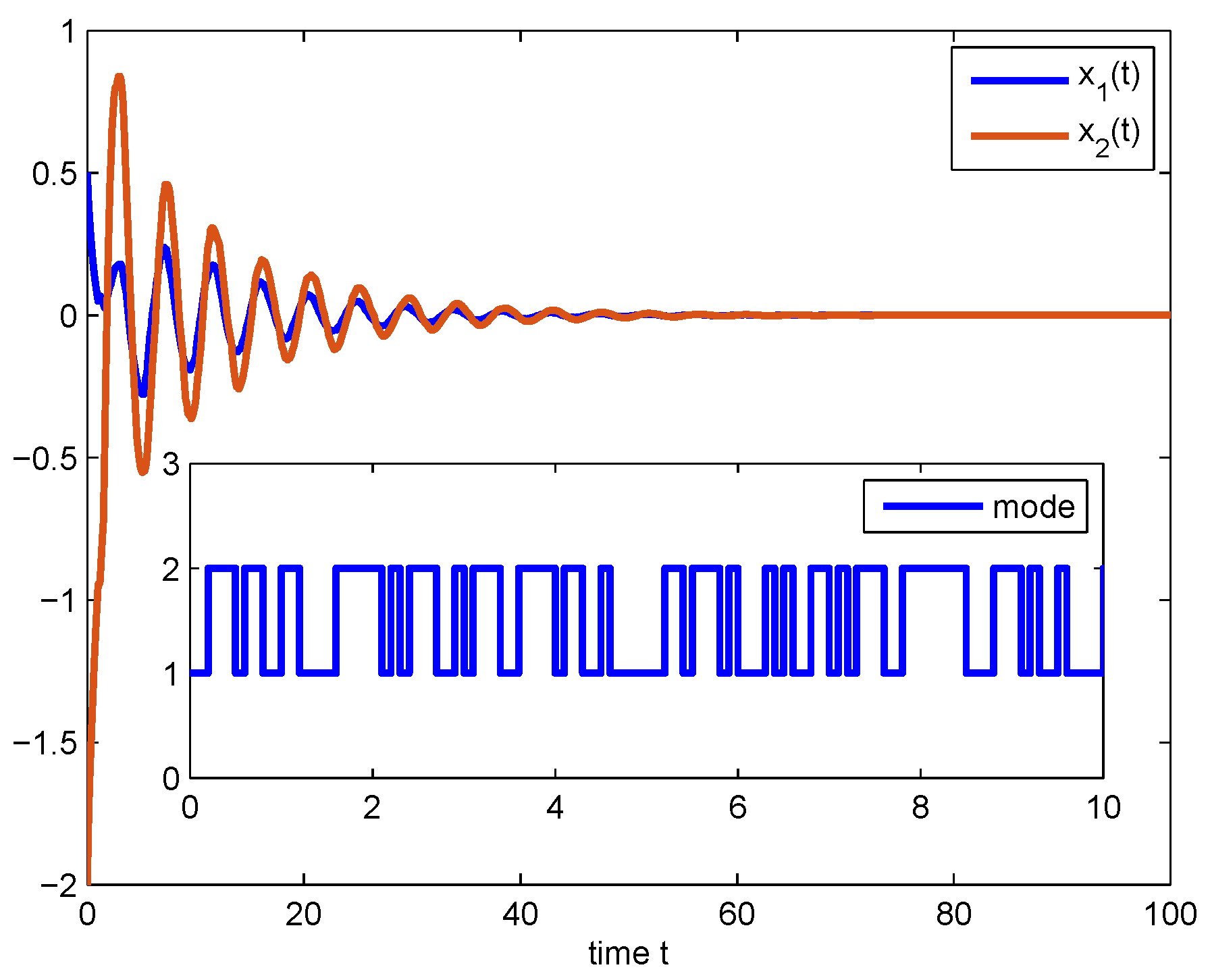Extended Dissipativity Analysis for Uncertain Neutral-Type Semi-Markovian Jump Systems via Two Integral Inequalities
Abstract
1. Introduction
- By introducing slack matrices and adjustable parameters, a parameter-dependent free-matrix-based single integral inequality is developed, which removes the incomplete slack matrices with zero components in [35] so that the relationship between system information becomes fully coupled.
- A parameter-dependent free-matrix-based double integral inequality is proposed based on slack matrices and adjustable parameters, which removes the incomplete slack matrices with zero components in [11]. In this case, more coupling information comes from triple integrals in LKF that can be captured.
- By the two advanced parameter-dependent integral inequalities, a less conservative extended dissipativity condition for uncertain NS-MJSs is proposed.
2. System Description
3. Main Results
4. Numerical Example
5. Conclusions
Author Contributions
Funding
Data Availability Statement
Conflicts of Interest
References
- Zeng, H.; He, Y.; Wu, M.; She, J. Free-matrix-based integral inequality for stability analysis of systems with time varying delay. IEEE Trans. Autom. Control 2015, 60, 2768–2772. [Google Scholar] [CrossRef]
- Gu, K.; Kharitonov, V.; Chen, J. Stability of Time-Delay Systems; Birkhauser: Cambridge, MA, USA, 2003. [Google Scholar]
- Seuret, A.; Gouaisbaut, F. Wirtinger-based integral inequality: Application to time-delay systems. Automatica 2013, 49, 2860–2866. [Google Scholar] [CrossRef]
- Zhang, H.; Yan, Y.; Mu, Y.; Ming, Z. Neural Network-Based Adaptive Sliding-Mode Control for Fractional Order Fuzzy System with Unmatched Disturbances and Time-Varying Delays. IEEE Trans. Syst. Man Cybern. Syst. 2023, 53, 5174–5184. [Google Scholar] [CrossRef]
- Tian, Y.; Su, X.; Shen, C.; Ma, X. Exponentially extended dissipativity-based filtering of switched neural networks. Automatica 2024, 161, 111465. [Google Scholar] [CrossRef]
- Zeng, H.; He, Y.; Wu, M.; She, J. New results on stability analysis for systems with discrete distributed delay. Automatica 2015, 60, 189–192. [Google Scholar] [CrossRef]
- He, Y.; Ji, M.; Zhang, C.; Wu, M. Global exponential stability of neural networks with time-varying delay based on free-matrix-based integral inequality. Neural Netw. 2016, 77, 80–86. [Google Scholar] [CrossRef]
- Park, M.; Kwon, O.; Park, J.; Lee, S.; Cha, E. Stability of time delay systems via Wirtinger-based double integral inequality. Automatica 2015, 55, 204–208. [Google Scholar] [CrossRef]
- Zhang, B.; Zheng, W.; Xu, S. Filtering of Markovian jump delay systems based on a new performance index. IEEE Trans. Circuits Syst. I 2013, 60, 1250–1263. [Google Scholar] [CrossRef]
- Li, F.; Wu, L.; Shi, P. Stochastic stability of semi-Markovian jump systems with mode-dependent delays. Int. J. Robust Nonlinear Control 2014, 24, 3317–3330. [Google Scholar] [CrossRef]
- Hua, C.; Wu, S.; Yang, X.; Guan, X. Stability analysis of time-delay systems via free-matrix-based double integral inequality. Int. J. Syst. Sci. 2017, 48, 257–263. [Google Scholar] [CrossRef]
- Saravanakumar, R.; Rajchakit, G.; Ahn, C.K.; Karimi, H.R. Exponential Stability, Passivity, and Dissipativity Analysis of Generalized Neural Networks with Mixed Time-Varying Delays. IEEE Trans. Syst. Man Cybern. Syst. 2019, 49, 395–405. [Google Scholar] [CrossRef]
- Xiong, L.; Cheng, J.; Liu, X.; Wu, T. Improved conditions for neutral delay systems with novel inequalities. J. Nonlinear Sci. Appl. 2017, 10, 2309–2317. [Google Scholar] [CrossRef]
- Ali, M.S.; Narayanan, G.; Nahavandi, S.; Wang, J.-L.; Cao, J. Global Dissipativity Analysis and Stability Analysis for Fractional-Order Quaternion-Valued Neural Networks with Time Delays. IEEE Trans. Syst. Man Cybern. Syst. 2022, 52, 4046–4056. [Google Scholar] [CrossRef]
- Faydasicok, O. New criteria for global stability of neutral-type Cohen-Grossberg neural networks with multiple delays. Neural Netw. 2017, 48, 257–263. [Google Scholar] [CrossRef]
- Arik, S. New criteria for stability of neutral-type neural networks with multiple time delays. IEEE Trans. Neural Netw. Learn. Syst. 2020, 15, 1504–1513. [Google Scholar] [CrossRef]
- Tian, Y.; Wang, Z. Extended dissipativity analysis for Markovian jump neural networks via double integral-based delay-product-type Lyapunov functional. IEEE Trans. Neural Netw. Learn. Syst. 2022, 32, 3240–3246. [Google Scholar] [CrossRef]
- Tian, Y.; Wang, Z. Finite-time extended dissipative filtering for singular T-S fuzzy systems with nonhomogeneous Markov jumps. IEEE Trans. Cybern. 2022, 52, 4574–4584. [Google Scholar] [CrossRef]
- Zhang, Y.; Lou, K.; Ge, Y. New Result on delay-dependent stability for Markovian jump time-delay systems with partial information on transition probabilities. IEEE/CAA J. Autom. Sin. 2019, 6, 1499–1505. [Google Scholar] [CrossRef]
- Dong, S.; Chen, C.L.; Fang, M.; Wu, Z. Dissipativity-based asynchronous fuzzy sliding mode control for T-S fuzzy hidden Markov jump systems. IEEE Trans. Cybern. 2019, 50, 4020–4030. [Google Scholar] [CrossRef]
- Fu, L.; Ma, Y.; Wang, C. Memory sliding mode control for semi-Markov jump system with quantization via singular system strategy. Int. J. Robust Nonlinear Control 2019, 29, 6555–6571. [Google Scholar] [CrossRef]
- Zong, G.; Ren, H. Guaranteed cost finite-time control for semi-Markov jump systems with event-triggered scheme and quantization input. Int. J. Robust Nonlinear Control 2019, 29, 5251–5273. [Google Scholar] [CrossRef]
- Yao, L.; Wang, Z.; Huang, X.; Li, Y.; Ma, Q.; Shen, H. Stochastic Sampled-Data Exponential Synchronization of Markovian Jump Neural Networks with Time-Varying Delays. IEEE Trans. Neural Netw. Learn. Syst. 2023, 34, 909–920. [Google Scholar] [CrossRef] [PubMed]
- Zhang, H.; Yan, Y.; Sun, J. A-Iterative Dual Heuristic Dynamic Programming for Nonlinear Critical Surfaces with Strong Constraints. IEEE Trans. Syst. Man Cybern. Syst. 2024, 54, 3334–3343. [Google Scholar] [CrossRef]
- Subramaniam, S.; Lim, C.P.; Rajan, R.; Mani, P. Synchronization of Fractional Stochastic Neural Networks: An Event Triggered Control Approach. IEEE Trans. Syst. Man Cybern. Syst. 2024, 54, 1113–1123. [Google Scholar] [CrossRef]
- Xu, Y.; Wu, Z.; Pan, Y.; Sun, J. Resilient Asynchronous State Estimation for Markovian Jump Neural Networks Subject to Stochastic Nonlinearities and Sensor Saturations. IEEE Trans. Cybern. 2022, 52, 5809–5818. [Google Scholar] [CrossRef]
- Wang, J.; Ma, S.; Zhang, C. Resilient estimation for T-S fuzzy descriptor systems with semi-Markov jumps and time-varying delay. Inf. Sci. 2018, 430, 104–126. [Google Scholar] [CrossRef]
- Yin, G.; Krishnamurthy, V.; Ion, C. Regime switching stochastic approximation algorithms with application to adaptive discrete stochastic optimization. SIAM J. Optim. 2004, 14, 1187–1215. [Google Scholar] [CrossRef]
- Huang, J.; Shi, Y.; Zhang, X. Active fault tolerant control systems by the semi-Markov model approach. Int. J. Adapt. Control Signal Process. 2014, 28, 833–847. [Google Scholar] [CrossRef]
- Xu, Z.; Wu, Z.; Su, H.; Shi, P.; Que, H. Energy-to-peak filtering of semi-markov jump systems with mismatched modes. IEEE Trans. Autom. Control 2020, 65, 4356–4361. [Google Scholar] [CrossRef]
- Shen, H.; Wu, Z.; Park, J. Reliable mixed passive and H∞ filtering for semi-Markov jump systems with randomly occurring uncertainties and sensor failures. Int. J. Robust Nonlinear Control 2015, 25, 3231–3251. [Google Scholar] [CrossRef]
- Xia, W.; Xu, S.; Ma, Q.; Qi, Z.; Zhang, Z. Dissipative controller design for uncertain neutral systems with semi-Markovian jumping parameters. Optim. Control Appl. Meth. 2018, 39, 888–903. [Google Scholar] [CrossRef]
- Sakthivel, R.; Kwon, O.; Choi, S.; Sakthivel, R. Observer-based state estimation for discrete-time semi-Markovian jump neural networks with round-robin protocol against cyber attacks. Neural Netw. 2023, 165, 611–624. [Google Scholar] [CrossRef] [PubMed]
- Sakthivel, R.; Sakthivel, R.; Kwon, O.; Selvaraj, P. Disturbance rejection for singular semi-Markov jump neural networks with input saturation. Appl. Math. Comput. 2021, 407, 126301. [Google Scholar] [CrossRef]
- Wu, T.; Xiong, L.; Cao, J.; Zhang, H. Stochastic stability and extended dissipativity analysis for uncertain neutral systems with semi-Markovian jumping parameters via novel free matrix-based integral inequality. Int. J. Robust Nonlinear Control 2019, 29, 2525–2545. [Google Scholar] [CrossRef]
- Liang, X.L.; Hou, M.Z.; Duan, G.R. Output feedback stabilization of switched stochastic nonlinear systems under arbitrary switchings. Int. J. Autom. Comput. 2013, 10, 571–577. [Google Scholar] [CrossRef]
- Wang, D.; Wu, F.; Lian, J.; Li, S. Observer-based asynchronous control for stochastic nonhomogeneous semi-Markov jump systems. IEEE Trans. Autom. Control 2023, 69, 2559–2566. [Google Scholar] [CrossRef]



| −2.105 | −2.103 | −2.1 | |
|---|---|---|---|
| Theorem 4 [12] | 1.6978 | 0.5747 | 0.3749 |
| Theorem 3.3 [13] | 1.7824 | 0.6030 | 0.3930 |
| Corollary 2 [35] | 1.7848 | 0.6038 | 0.3935 |
| Theorem 1 | 1.7874 | 0.6051 | 0.3942 |
Disclaimer/Publisher’s Note: The statements, opinions and data contained in all publications are solely those of the individual author(s) and contributor(s) and not of MDPI and/or the editor(s). MDPI and/or the editor(s) disclaim responsibility for any injury to people or property resulting from any ideas, methods, instructions or products referred to in the content. |
© 2025 by the authors. Licensee MDPI, Basel, Switzerland. This article is an open access article distributed under the terms and conditions of the Creative Commons Attribution (CC BY) license (https://creativecommons.org/licenses/by/4.0/).
Share and Cite
Gao, Z.; Zhang, H. Extended Dissipativity Analysis for Uncertain Neutral-Type Semi-Markovian Jump Systems via Two Integral Inequalities. Machines 2025, 13, 443. https://doi.org/10.3390/machines13060443
Gao Z, Zhang H. Extended Dissipativity Analysis for Uncertain Neutral-Type Semi-Markovian Jump Systems via Two Integral Inequalities. Machines. 2025; 13(6):443. https://doi.org/10.3390/machines13060443
Chicago/Turabian StyleGao, Zihao, and Huaguang Zhang. 2025. "Extended Dissipativity Analysis for Uncertain Neutral-Type Semi-Markovian Jump Systems via Two Integral Inequalities" Machines 13, no. 6: 443. https://doi.org/10.3390/machines13060443
APA StyleGao, Z., & Zhang, H. (2025). Extended Dissipativity Analysis for Uncertain Neutral-Type Semi-Markovian Jump Systems via Two Integral Inequalities. Machines, 13(6), 443. https://doi.org/10.3390/machines13060443






